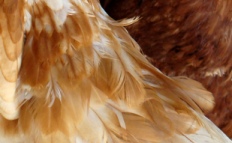From chicken feathers to flower pots

Chicken feathers, usually an unwanted byproduct of poultry processing, may have a more valuable future as an ingredient in biodegradable flower pots, according to an Agricultural Research Service (ARS) scientist.
Chemist Walter Schmidt, in the ARS Environmental Management and Byproduct Utilization Laboratory in Beltsville, Md., has been developing practical uses for discarded chicken feathers. Each year, approx. 4 bln pounds of chicken feathers are left over after processing in the US.
Working with the Horticultural Research Institute (HRI) in Washington, DC, Schmidt and HRI research associate Masud Huda have formulated planting pots that degrade over variable periods of time, ranging from 1 to 5 years.
The pots look and feel like any other plastic planters encountered at your local nursery, but they are made to disintegrate naturally, without harm to the environment. In fact, the pots–manufactured without any petroleum components–would slowly release beneficial nitrogen to the soil.
In 2002, Schmidt and Justin Barone, a former ARS research associate, found feather-derived plastic could be molded just like any other plastic and has properties very similar to plastics such as polyethylene and polypropylene. This makes the feather-derived plastic a unique material for packaging or any other application where high strength and biodegradability are desired, according to Schmidt. In 2006, the process of making composites and films from feather keratin was patented by ARS.
Schmidt and Huda are now working to develop fully biodegradable flowerpots. Several commercial pot manufacturers are involved in this phase to determine optimum production-scale molding specifications for the containers. According to Schmidt, the “green” horticultural end products will not only help solve the environmental problem by creating biodegradable plastics, but will also provide a cost-effective commercial use for feathers.
Source: Agricultural Research Service (ARS)













